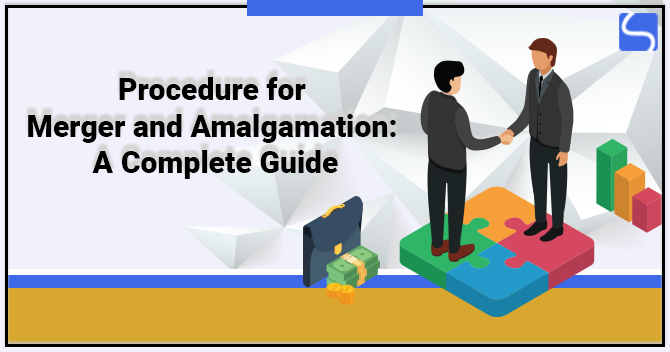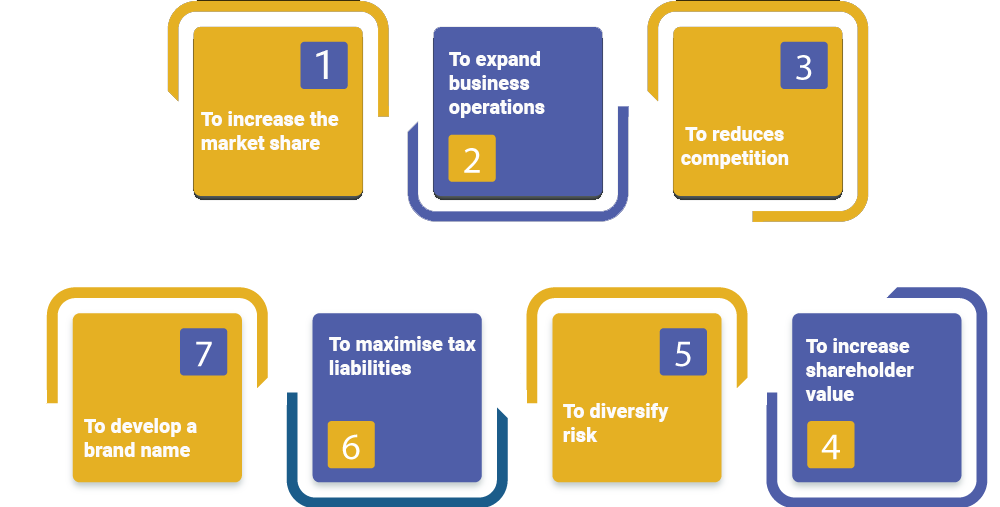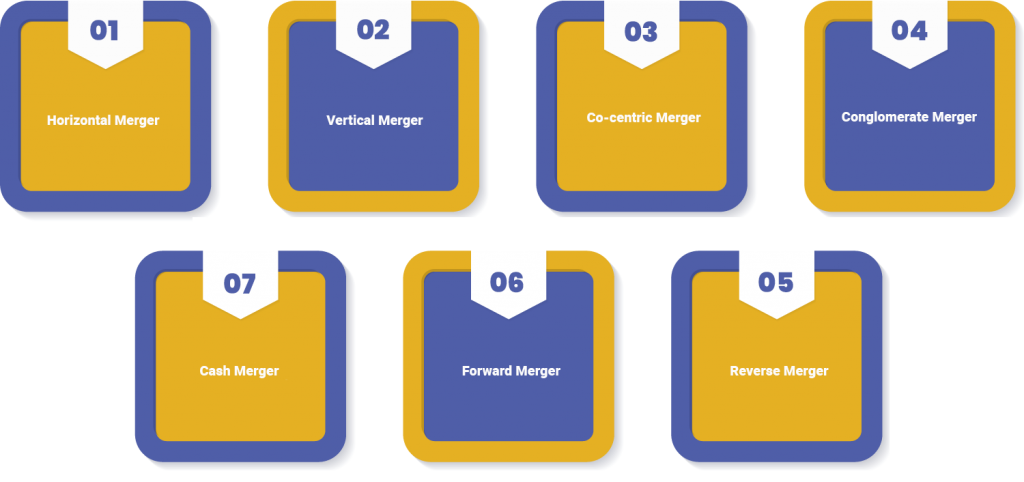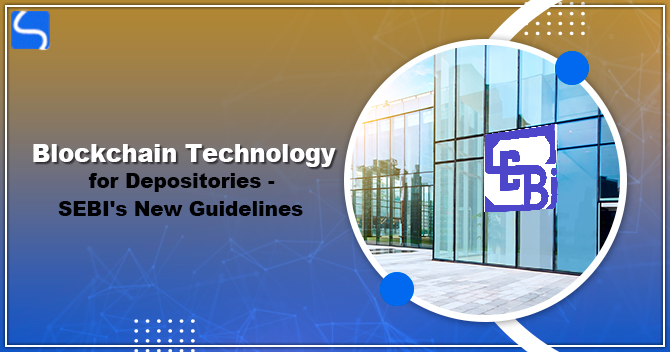Procedure for Merger and Amalgamation: A Complete Guide

Shivani Jain | Updated: Feb 26, 2021 | Category: Merger and Amalgamation, SEBI Advisory
Due to the continuously changing dynamics, increased competition, advanced technologies, and globalization, the deals concerning Merger and Amalgamation have become very much common these days. Therefore, it shall be noted that every company that wish to expand its business operations chooses to undergo the procedure for Merger and Amalgamation.
In this blog, we will cover the concept and procedure for Merger and Amalgamation.
Table of Contents
Concept of Merger and Amalgamation
Normally, Merger and Amalgamation are often considered as one, but the same are the two different concepts. The term merger means a combination of two or more business entities who decide to combine and form a company. In contrast, the term amalgamation means the association of two or more business entities into one.
Further, the parties involved in the process of merger are Transferor and Transferee, whereas, in the case of Amalgamation, the parties involved in a deal are Amalgamated Company and Amalgamating Company.
Also, Read: Difference between Merger and Amalgamation in India
Benefits of the Procedure of Merger and Amalgamation
The key benefits of the process of Merger and Amalgamation are as follows:

- To increase the market share;
- To expand business operations;
- To reduces competition;
- To increase shareholder value;
- To diversify risk;
- To maximise tax liabilities;
- To develop a brand name;
Laws Governing the Process of Merger and Amalgamation
The laws governing the process of Merger and Amalgamation are as follows:
- Companies (Compromises, Arrangements, and Amalgamations) Rules 2016;
- Companies Act 2013;
- Foreign Exchange Management Act 1999;
- Competition Act 2002;
- Income Tax Act 1961;
- Indian Stamp Duty Act 1899;
- SEBI (Substantial Acquisition of Shares and Takeover) Regulations 2011;
Different Types of Merger in India
The different types of Merger are as follows:

Horizontal Merger
The term Horizontal Merger means a situation wherein two or more companies who are dealing in similar nature products decide to combine their operations. The benefits of this type of merger are as follows:
- To Reduce Competition;
- To Acquire Dominant Market Position;
- To Expand Market Reach;
For example: Brook Bond and Lipton India, Hindustan Unilever and Patanjali.
Vertical Merger
The term Vertical Merger means a combination in which two or more companies, although deal in similar types of products, but the stages of production at which they operate are different.
For example: Reliance Industries and FLAG Telecom Group.
Co-centric Merger
Co-centric Merger means a situation wherein the organisations that serve the same type of customers merge. That means the products and services of both companies must complement each other.
For example: Axis Bank acquiring Freecharge, Flipkart acquiring Walmart India, Citi Group acquiring Salomon Smith Barney, etc.
Conglomerate Merger
Whenever two or more unrelated industries or companies decide to merge with each other, then, in that case, the same is termed as Conglomerate Mergers. Further, it shall be noted that the aims and objectives of both entities are completely different from each other in this case. However, the main reason for this type of merger is to expand and boost business in terms of size, operations, and profits.
For example: Voltas Ltd and L&T
Cash Merger
In this type of Merger, the shareholders are offered cash in place of the shares of the newly incorporated company.
Forward Merger
Whenever a company or an entity chooses to merge with its prospective customers, the same is known as Forward Merger.
For example: ICICI Bank acquired Bank of Mathura
Reverse Merger
In the case of Reverse Mergers, a company chooses to merge or combine with its suppliers.
For example: Gujarat Godrej Innovative Chemicals acquired the Godrej soap.
Different Types of Amalgamation in India
The different types of Amalgamation are as follows:
Amalgamation in the Nature of Merger
In case both the Transferor and the Transferee Company choose to combine their shareholding, together with their assets and liabilities, the same is known as Amalgamation in the Nature of Merger.
Further, under this kind of amalgamation, modifications and alterations are made to the recorded values of the assets and liabilities. Also, the shareholders of the Transferor Company become the members or shareholders of the Transferee Company, that, too with at least 90% of the total shareholding.
Amalgamation in the Nature of Purchase
In case the conditions and stipulations for the amalgamation in the nature of merger are not properly satisfied, then, in that case, the same deal will be termed as the Amalgamation in the Nature of Purchase.
Further, under this method, a transferor company acquires or purchases a transferee company, but the shareholder of the transferee company will not have any proportionate shareholding in the amalgamated company.
Procedure for Merger and Amalgamation in India
The steps involved in the procedure for Merger and Amalgamation in India are as follows:

File Application with NCLT
In the first step of the procedure for Merger and Amalgamation, all the directors of the applicant company need file an application with the National Company Law Tribunal in form NCLT – 1, together with the required documents. That means the transferor and transferee company are qualified to file an application or petition with the NCLT to obtain approval for the process of amalgamation.
Further, the said application must be filed under section 230 – 232 of the Companies Act 2013. However, if in case the parties involved have their registered office in the same state, then, in that case, they can furnish a joint application. However, if they have their offices in two different states, then, in that case, they need to file separate applications in the respective states.
Also, the documents required for the application are as follows:
- Form NCLT – 2 for the Notice of Admission;
- Form NCLT – 6 as affidavit with the disclosures as follows:
- Material Facts of the Applicant Company;
- Latest Financial Statements of the Company;
- Details about any Pending Legal Proceedings;
- Reduction of the Share Capital;
- A certified copy of the Scheme of Compromise and Arrangement;
- Any Corporate Debt Restructuring Scheme, which is agreed to be not less than 75% of the total secured creditors. Such a scheme must include the annexures as follows:
- Form CAA 1 as the Creditor Responsibility Statement;
- Safeguards to protect Secured and Unsecured Creditors;
- Auditor’s Report;
- Declaration stating that the company has duly complied with all the requirements as specified by the Reserve Bank of India;
- Valuation Report for the assets, shares, and property of the applicant company;
Holding of Meeting by NCLT
Now, in the next step of the procedure for Merger and Amalgamation, the tribunal will pass an order for holding the Meeting for Creditors if it gets satisfied with the petition and documents filed. Further, the agenda of the said meeting will include the following:
- To fix the date, venue, and time of the meeting;
- To appoint the chairperson for the said meeting;
- To fix the remuneration and terms of the appointed chairperson;
- To decide the procedure and quorum of the meeting;
- To decide the mode of voting, which should be from either of the following:
- Voting by Show of Hands;
- Voting by Postal Ballot;
- Voting by Proxy;
- To determine the Total Value of the Creditors;
- To provide the Notice for Meeting, together with Advertisement;
Notice for Creditors Meeting
Further, in the procedure for Merger and Amalgamation, the company requires to send a notice to the creditors in form CAA – 2, together with the details regarding the following:
- Notice must be sent to each of the member, creditor, and debenture holder at their respective registered address;
- The said notice must be sent either by the liquidator or the company’s chairman;
- The modes of sending the notice are as follows:
- Courier;
- Speed Post;
- Registered Post;
- Hand Delivery;
- E-mail;
- Any other registered means;
Documents Attached with the Notice
The documents attached with the Notice are as follows:
- A certified copy of the scheme of Amalgamation;
- Details of the passed NCLT Order concerning the guidelines for the meeting;
- Details of the Company as follows:
- Company Identification Number of the Company;
- Permanent Account Number of the Company;
- Name of the Company;
- Incorporation Date;
- Nature of the Company, such as Private Limited Company, Public Limited Company, or One Person Company;
- Address of the Registered Office;
- Authorised Share Capital of the Company;
- Total Paid up Share Capital of the Company;
- Name, Address, and basic details of the Promoters and Directors;
- In the case of Joint Application, facts and details of the parties involved;
- Details of the Board Meeting in which the procedure for Merger and Amalgamation was approved;
- The Explanatory Statement of the Notice must have the details as follows:
- Parties Involved;
- Ratio for Share Exchange;
- Effective Date;
- Appointed Date;
- Summary of the Valuation Report;
- Details concerning Debt and Capital Restructuring;
- Amount outstanding to Unsecured Creditors
- Disclosures of the effects of the Procedure for Merger and Amalgamation on the following:
- Key Managerial Personnel;
- Promoters;
- Directors;
- Non Promoter Members;
- Creditors;
- Depositors;
- Deposit Holders;
- Debenture Trustee;
- Shareholders;
- Employees;
- Details regarding the pending proceedings or litigation;
- Details of approval or sanction from the regulatory government authorities;
- Statement concerning the people eligible to attend and vote in the Creditors Meeting;
NCLT Order
If in case the National Company Law Tribunal is satisfied with the procedure followed, it will pass an order in favour of the scheme of merger and amalgamation, together with the required directions.
Conclusion
In a nutshell, the procedure for Merger and Amalgamation is a scheme of compromise and arrangement undertaken by companies who wish to expand their business operations and boost their client reach. Further, it shall be noted that the term merger and amalgamation are two different concepts instead of one. Furthermore, to undergo the procedure for Merger and Amalgamation, one needs to follow the steps mentioned above.
Also, Read: MCA Allows the Entry of Start-up Companies into the Scheme of Merger and Amalgamation














